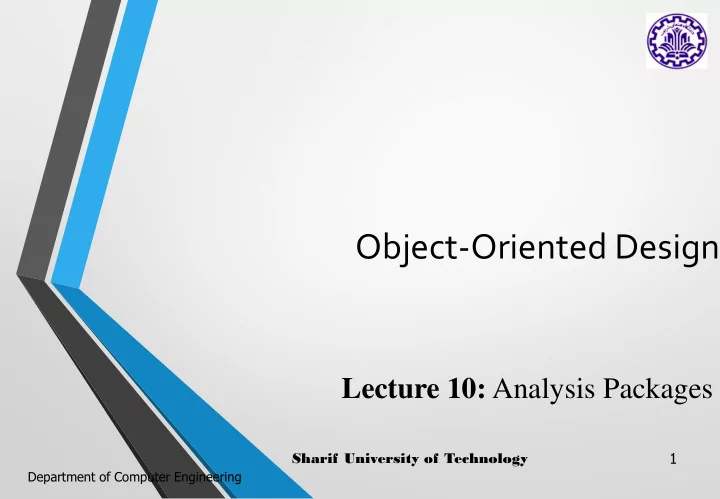

Object-Oriented Design Lecture 10: Analysis Packages Sharif University of Technology 1 Department of Computer Engineering
Analysis Workflow: Packages • The analysis workflow consists of the following activities: • Architectural analysis • Analyze a use case • Analyze a class • Analyze a package 2 Sharif University of Technology
Packages • The package is the UML mechanism for grouping things. • Packages serve many purposes: • they group semantically related elements; • they provide units of configuration management and parallel work; • they provide an encapsulated namespace in which all names must be unique - to access an element within the namespace you must specify both the element name and the namespace name. • Every model element is owned by one package: • the packages form a hierarchy; • the root package may be stereotyped «topLevel»; • by default, model elements are placed in the «topLevel» package. 3 Sharif University of Technology
Package Visibility and Stereotypes • Package elements may have visibility: • visibility is used to control the coupling between packages; • there are two levels of visibility: • public (+) - elements are visible to other packages; • private (-) - elements are completely hidden. • Package stereotypes: • «Framework»- a package that contains model elements that specify a reusable architecture; • «modelLibrary»- a package that contains elements that are intended to be reused by other packages. • A package defines an encapsulated namespace: • use qualified names to refer to elements in other packages, for example: 4 Library::Users::Librarian
Packages: Example 5 Sharif University of Technology
Nested Packages • The inner package can see all of the public members of its outer packages; • The outer package can't see any of the members of its inner packages unless it has an explicit dependency on them (usually «access» or «import») • this allows you to hide implementation details in nested packages. Library::Users::Librarian 6 Sharif University of Technology
Package Dependencies • A dependency relationship between packages indicates that the client package depends in some way on the supplier package. • «use» (default) - an element in the client package uses a public element in the supplier package. • «import» - public elements of the supplier namespace are added as public elements to the client namespace. Elements in the client can access all public elements in the supplier by using unqualified names. • «access» - public elements of the supplier namespace are added as private elements to the client namespace. Elements in the client can access all public elements in the supplier by using unqualified names. • «trace» - the client is a historical development of the supplier. This usually applies to models rather than elements. • «merge» - public elements of the supplier package are merged with elements of the client package. Only used in metamodeling. 7 Sharif University of Technology
Package Dependencies 8 Sharif University of Technology
Relationship Transitivity • Transitivity: If A has a relationship to B and B has a relationship to C, then A has a relationship to C. • «import» is transitive. • «access» is not transitive. 9 Sharif University of Technology
Package Generalization • Very similar to class generalization; • The child packages: • inherit elements from their parent package; • can add new elements; • can override parent elements. 10 Sharif University of Technology
Architectural Analysis and Package Analysis • identify subsystem architecture; • partition cohesive sets of analysis classes into analysis packages; • layer analysis packages according to their semantics; • attempt to minimize coupling by: • minimizing package dependencies; • minimizing the number of public elements in all packages; • maximizing the number of private elements in all packages. 11 Sharif University of Technology
Finding Analysis Packages • Examine subsystems. • Examine analysis classes - look for: • cohesive clusters of closely related classes; • inheritance hierarchies; • classes are most closely related by (in order) inheritance, composition, aggregation, dependency. • Examine use cases: • clusters of use cases that support a particular business process or actor may have analysis classes that should be packaged together; • related use cases may have analysis classes that should be packaged together; • be careful - analysis packages often cut across use cases! • Refine the package model to maximize cohesion within packages and minimize dependencies between packages by: • moving classes between packages; • adding packages; • removing packages; 12 • remove cyclic dependencies by merging packages or by splitting them.
Finding Analysis Packages 13 Sharif University of Technology
Eliminating Cyclic Package Dependencies 14 Sharif University of Technology
Reference • Arlow, J., Neustadt, I., UML 2 and the Unified Process: Practical Object- Oriented Analysis and Design , 2 nd Ed. Addison-Wesley, 2005. 15 Sharif University of Technology
Recommend
More recommend